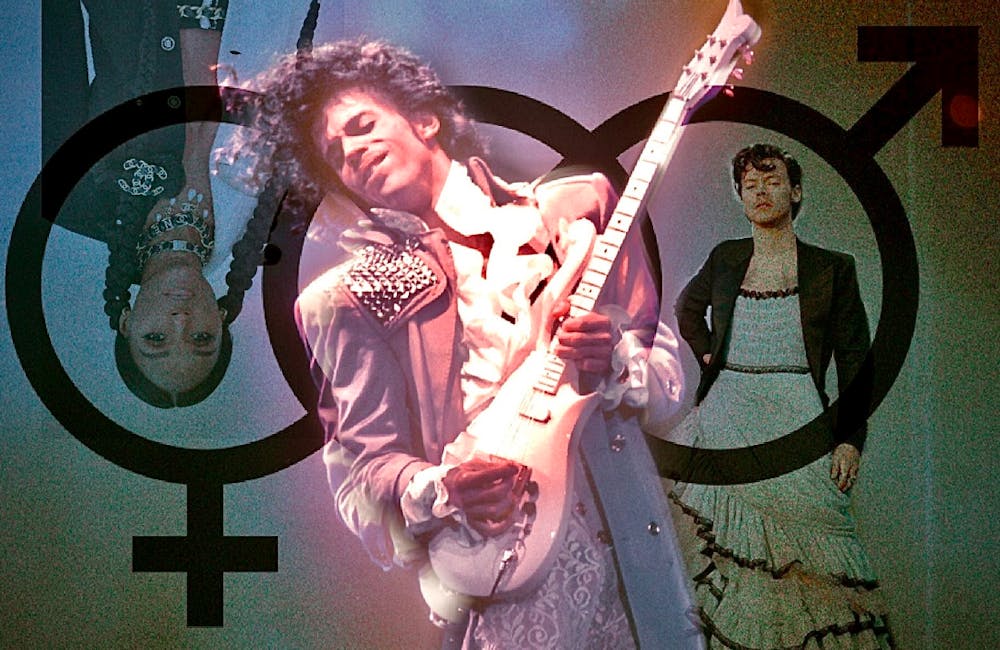A windswept Harry Styles clad in a baby blue Gucci dress graces the December cover of Vogue. As the glossy images circulated online, the internet took to scrutinizing the ex–boyband member. Yes, the cover is most certainly “camp,” but more critically: Could this nod to a future of genderless fashion?
As expected, Twitter users dissected the image with attitudes ranging from awe to rage. First, conservatives felt inclined to comment on the dress.
Although baseless, Candace Owens and Ben Shapiro bring to light an intriguing point: the steady “feminization of our men.” Candace blames this “feminization” to a rise in Marxism, but to that I ask: In what ways does “feminization” equate to being inherently less strong? Also, any form of self–expression displays a certain degree of autonomy and freedom. I’d argue that unconventional self–expression—if anything is democratic.
Upset conservative critics aside, the opposite end of the political spectrum criticized the performative aspect of the Vogue cover. Young people in the LGBTQ community rolled their eyes at the glorification of a cis man wearing a dress.
Conversation around gender is intrinsically linked to LGBTQ spaces. Twitter recently released, “Gender Redefined," a report on cultural insights on Twitter conversations. The report found that between 2016 to 2019, conversations around gender and gender roles increased by 176%, while derogatory terms around gender decreased by 57%. Marginalized twitter users have advocated for visibility with the hashtags like #WontbeErased and movements of solidarity—such as #HeforShe—have also shifted biases around gender.
Now, back to Vogue. A now–deleted viral tweet placed images of Conan Gray and Harry Styles side–by–side, paired with the statement, “They invented gender–fluidity in the music industry let’s be honest.” The user later clarified that the tweet was meant as a joke, and the post–tweet rage that ensued points to the subtle genius of sarcasm. Twitter users quickly stormed in, responding with threads of famous musicians who set the tone for gender–expression in the industry. Other users quickly dismissed the tweet, labeling Vogue’s cover as “queer–baiting” and posed the question: What’s gender–fluid about two cis people?
Any magazine cover that incites such strong opinions is a success. After all, media serves our world to create such discussion and controversy.
First, let’s not take away from the history of gender expression in the music industry. Think of Prince’s long dark hair paired with dainty lace gloves and his iconic purple blazer. Michael Jackson’s sequined suits and eyeliner–rimmed eyes. Musicians have long used fashion as an opportunity for creative expression, bending the rules of expected presentation.
More specifically, Black musicians in the industry have often led the discussion on masculinity in the arts. Modern examples beyond Prince are Lenny Kravitz and Lil Nas X—both men choose to mix feminine and masculine accessories in public. In addition, Janelle Monae identifies as non–binary and can often be spotted in both dresses and sleek monochrome suits on the red carpet.
Meanwhile, Vogue covers have long been a symbol of change. Its iconic images shape and challenge the reality of fashion. The December cover is radical. Perhaps, it can allow us to imagine something even more earth–shattering: a complete shift in the fashion industry that erases the gender binary in both high fashion and everyday life.
On the more high–fashion end, Marc Jacobs has been a leading designer in challenging gender expression. He can be seen stomping in platform boots and jewel–toned glitter eyeshadow on his Instagram. Recently, he’s been named GQ’s “Most Stylish Person of the Year.” Most notably, Gucci has interchangeably modeled clothing on men and women and of course, chosen to debut their newest collection on Harry himself.
Along with high–fashion, Gen–Z is a leading force in non–binary expression. A recent survey from Vice found that up to 41 percent of Gen Z identify as neutral on the gender spectrum, rather than strictly sticking to feminine or masculine forms of expression. This transfers directly to retail: 56 percent of Gen Z consumers already shop outside of their gender, dismissing gendered clothing labels. So, beyond posed Vogue covers and couture seasons, we can consider this: In what ways can brands make non–binary clothing more accessible?
Uniqlo’s utilitarian, almost uniform–like clothing is a nod to this. Their orms are often gender neutral. In fact, the website has championed a unisex subsection. In 2020, Zara released the clothing line, “Ungendered,” a 16–item line of unisex basics. While these pieces are not shockingly original, the use of gender neutral terms is shifting the attitude of ungendered clothing in mainstream retail.
Outside of the elite bubble of celebrities and couture designers, the future of fashion lies in the ability to experiment with forms, colors, and patterns beyond traditional expectation. Although brands are starting to catch on, accessible retail still has a long way to go.
The Vogue cover is a start. Now, we can begin to imagine a world in fashion where traditional gender norms are obsolete.







